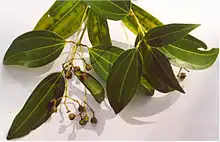Cinnamomum verum
Cinnamomum verum,[2] called true cinnamon tree or Ceylon cinnamon tree, is a small evergreen tree belonging to the family Lauraceae, native to Sri Lanka.[3] Although the inner bark of several other Cinnamomum species is also used to make cinnamon, cinnamon from C. verum is considered by culinarians to be of superior quality.
| Cinnamomum verum | |
|---|---|
 | |
| Cinnamomum verum foliage and flowers | |
| Scientific classification | |
| Kingdom: | Plantae |
| Clade: | Tracheophytes |
| Clade: | Angiosperms |
| Clade: | Magnoliids |
| Order: | Laurales |
| Family: | Lauraceae |
| Genus: | Cinnamomum |
| Species: | C. verum |
| Binomial name | |
| Cinnamomum verum | |
| Synonyms | |
| |
Description
Cinnamomum verum trees are 10–15 metres (30–50 feet) tall. The leaves are ovate-oblong in shape and 7–18 cm (3–7 inches) long. The flowers, which are arranged in panicles, have a greenish color and a distinct odor. The fruit is a purple 1-cm drupe containing a single seed.[4]
Cultivation
The old botanical synonym for the tree, Cinnamomum zeylanicum, is derived from Sri Lanka's former name, Ceylon.[5] Sri Lanka still produces 80–90%[6] of the world's supply of C. verum, which is also cultivated on a commercial scale in the Seychelles and Madagascar.[7]
Cultivars
There are several different cultivars of Cinnamomum verum based on the taste of bark:[8]
- Type 1 – Sinhala: Pani Kurundu (පැණි කුරුඳු), Pat Kurundu (පත් කුරුඳු), Mapat Kurundu (මාපත් කුරුඳු); Tamil: Ten Lavangapattai (தேன் இலவங்கப்பட்டை), Karamana lavangapattai (காரமான இலவங்கப்பட்டை), Taramana Lavangapattai (தரமான இலவங்கப்பட்டை)
- Type 2 – Sinhala: Naga Kurundu (නාග කුරුඳු); Tamil: Naka Lavangapattai (நாகா இலவங்கப்பட்டை)
- Type 3 – Sinhala: Pani Miris Kurundu (පැණි මිරිස් කුරුඳු); Tamil: Juci Milakay Lavangapattai (ஜூசி மிளகாய் இலவங்கப்பட்டை)
- Type 4 – Sinhala: Weli Kurundu (වැලි කුරුඳු); Tamil: Manal Lavangapattai (மணல் இலவங்கப்பட்டை)
- Type 5 – Sinhala: Sewala Kurundu (සෙවල කුරුඳු); Tamil: Vettappattatu Lavangapattai (வெட்டப்பட்டது இலவங்கப்பட்டை)
- Type 6 – Sinhala: Kahata Kurundu (කහට කුරුඳු); Tamil: Manyal Nira Lavangapattai (மஞ்சள் நிற இலவங்கப்பட்டை
- Type 7 – Sinhala: Peiris Kurundu (පීරිස් කුරුඳු); Tamil: Piris Lavangapattai (பீரிஸ் இலவங்கப்பட்டை)
Processing
The trees grow as leafy bushes, usually maxing out about 3 meters (10 ft) in height. They are first harvested at 3 years old, and continue producing well for 40-50 years. Small side branches (1.5-5 cm in diameter) are removed from the trees. The outer bark is removed, and made into mulch. Twigs, leaves & berries (seeds) are crushed and make cinnamon oil, a less valuable byproduct. The inner bark of the branches is loosened by being rubbed with a brass rod, then split with a brass or stainless steel knife, and then peeled off, as intact as possible. Long, full 'quills' of cinnamon are more valuable than broken pieces. These quills are then dried over several days, in the shade, then in darkness. All this work is done by hand by experienced workers; this is the most expensive part of producing cinnamon spice. Finally, the dried bark is cut into sticks or ground into powder for sale to consumers.
Gallery
 Leaves of the Cinnamomum verum plant
Leaves of the Cinnamomum verum plant Leaves of the Cinnamomum verum plant
Leaves of the Cinnamomum verum plant Bark, powder and dried flowers from Cinnamomum verum plant
Bark, powder and dried flowers from Cinnamomum verum plant
References
- "Cinnamomum verum J.Presl — The Plant List". www.theplantlist.org.
- "NCBI – Cinnamomum verum". National Center for Biotechnology Information. Retrieved 4 October 2016.
- "Cinnamon". Encyclopædia Britannica. 2008.
(species Cinnamomum zeylanicum), bushy evergreen tree of the laurel family (Lauraceae) native to Bangladesh, Sri Lanka (Ceylon), the neighboring Malabar coast of India, and Myanmar (Burma), and also cultivated in South America and the West Indies for the spice consisting of its dried inner bark. The bark is widely used as a spice due to its distinct odor.
- Cinnamomum verum Cinnamon, Ceylon Cinnamon Tree PFAF Plant Database
- "In pictures: Sri Lanka's spice of life". BBC News.
- "True cinnamon is pricey, but is there an honest difference?". Truly Ceylon Cinnamon. 2018-12-14. Retrieved 2019-04-19.
- Iqbal, Mohammed (1993). "International trade in non-wood forest products: An overview". FO: Misc/93/11 – Working Paper. Food and Agriculture Organization of the United Nations. Retrieved November 12, 2012.
- "Archived copy". Archived from the original on 2017-04-28. Retrieved 2015-10-04.CS1 maint: archived copy as title (link)
External links
 Media related to Cinnamomum verum at Wikimedia Commons
Media related to Cinnamomum verum at Wikimedia Commons Data related to Cinnamomum verum at Wikispecies
Data related to Cinnamomum verum at Wikispecies